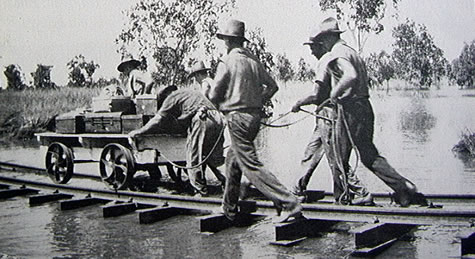THEME: Pine Creek area
SUBJECT AREA: history
TOPIC: mining
The small town of Pine Creek, 220 kms south of Darwin, has been our camp for the past 24 hours. It, like so many other places along our route, has a colourful historical past.
In the early 1870s, workers on the Overland Telegraph Line discovered gold in the area. The subsequent gold rush lasted for the next twenty years. A telegraph station was opened in 1874 and, at the same time, a large influx of Chinese workers was brought in by Europeans to do the tough work in the goldfields. By the mid-1880s, the Chinese outnumbered Europeans 15 to one in Pine Creek.

Many of the local Chinese were goldfield labourers; however, a large number became businessmen and merchants. A fire in 1892 destroyed all but one of their businesses. When the gold ran out, the population of Pine Creek dwindled and most of the Chinese returned to their homeland in the 1890s.
The trip to the goldfields was not an easy one. The nearest settlement of Palmerston (Darwin) had no road to Pine Creek and the government was unwilling to spend money on building one. A person travelling horseback could reach the goldfields in a few days time, however a wagon laden with mining supplies could consider a six-week journey to Pine Creek. Finally, the decision was made to build a railroad, and in 1889 the North Australian Railway was completed.
The pastoral industry has been a mainstay of the existence of Pine Creek throughout this time period. Recently, the mining of gold has impacted the town’s economy once again with an open cut mine on the edge of town.
From 1906 through 1915, the government sponsored a diamond-drilling project, sinking the Enterprise shaft. At the end of this time, work ceased due to World War I. The mine was sold in 1933 and not reopened until the 1960s, when it was worked intermittently for the next twenty years. In the 1970s, Jingellic Minerals purchased the leases over the Enterprise. Goldfields Exploration commenced operation of the mine in 1981and for the next fifteen years, the mine was worked on occasion until October 1995 when operations ceased and the open pit mine was filled with water.
The mine was drilled at a depth of 135 metres, its width 250 metres at the widest point. Gold produced in the area between 1985-1995 yielded 764,000 ounces, a dollar value of $393 million from all open pit mines.
Suggested activities: Discover the differences/similarities between open pit mines and shaft mines, comparing and contrasting your findings. Has mining played a role in the development of your area? How might it impact the settlement of a region, i.e. what types of businesses might be opened to accommodate the mines? How could the opening of a mine impact settlement of an area?
April